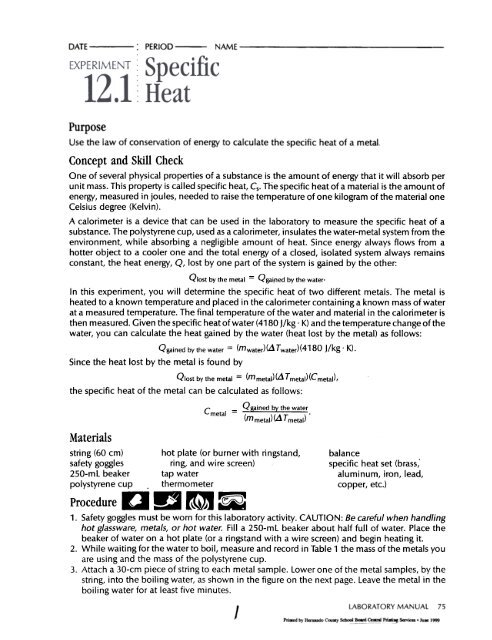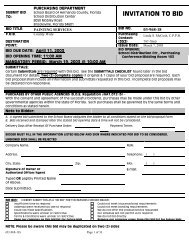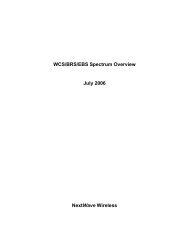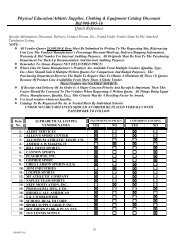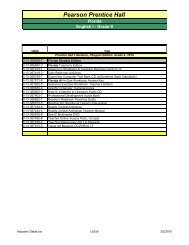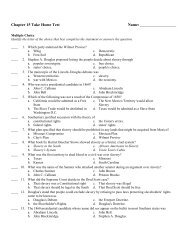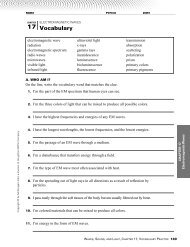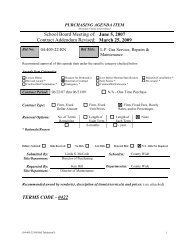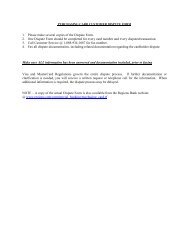specific heat set (b
specific heat set (b
specific heat set (b
Create successful ePaper yourself
Turn your PDF publications into a flip-book with our unique Google optimized e-Paper software.
DATE: PERIOD NAME<br />
Purpose<br />
Use the law of conservation of energy to calculate the <strong>specific</strong> <strong>heat</strong> of a metal.<br />
Concept and Skill Check<br />
One of several physical properties of a substance is the amount of energy that it will absorb per<br />
unit mass. This property is called <strong>specific</strong> <strong>heat</strong>, Cs. The <strong>specific</strong> <strong>heat</strong> of a material is the amount of<br />
energy, measured in joules, needed to raise the temperature of one kilogram of the material one<br />
Celsius degree (Kelvin).<br />
A calorimeter is a device that can be used in the laboratory to measure the <strong>specific</strong> <strong>heat</strong> of a<br />
substance. The polystyrene cup, used as a calorimeter, insulates the water-metal system from the<br />
environment, while absorbing a negligible amount of <strong>heat</strong>. Since energy always flows from a<br />
hotter object to a cooler one and the total energy of a closed, isolated system always remains<br />
constant, the <strong>heat</strong> energy, Q, lost by one part of the system is gained by the other:<br />
Qlost by the metal = Qgai,ned by the water.<br />
In this experiment, you will determine the <strong>specific</strong> <strong>heat</strong> of two different metals. The metal is<br />
<strong>heat</strong>ed to a known temperature and placed in the calorimeter containing a known mass of water<br />
at a measured temperature. The final temperature of the water and material in the calorimeter is<br />
then measured. Given the <strong>specific</strong> <strong>heat</strong> of water (4180 J/kg .K) and the temperature change of the<br />
water, you can calculate the <strong>heat</strong> gained by the water (<strong>heat</strong> lost by the metal) as follows:<br />
Qgained by the water = (mwateJ(L1TwateJ(4180<br />
J/kg .K).<br />
Since the <strong>heat</strong> lost by the metal is found<br />
by<br />
Qlost by the metal = (m metal) (L1 T metal) (C metal) ,<br />
the <strong>specific</strong> <strong>heat</strong> of the metal can be calclllated as follows:<br />
C<br />
metal<br />
-Qgained<br />
-<br />
(<br />
by the water<br />
{ A ) .<br />
m metal \LI T metaU<br />
Materials<br />
string (60 cm) hot plate (or burner with ringstand, balance<br />
safety goggles ring, and wire screen) <strong>specific</strong> <strong>heat</strong> <strong>set</strong> (brass;<br />
250-mL beaker tap water aluminum, iron, lead,<br />
polystyrene cup thermometer copper, etc.)<br />
Procedure D D 9 ~<br />
1. Safety goggles must be worn for this laboratory activity. CAUTION: Be careful when handling<br />
hot glassware, metals, or hot water. Fill a 250-mL beaker about half fuji of water. Place the<br />
beaker of water on a hot plate (or a ringstand with a wire screen) and begin <strong>heat</strong>ing it.<br />
2. While waiting for the water to boil, measure and record in Table 1 the mass of the metals you<br />
are using and the mass of the polystyrene cup.<br />
3. Attach a 30-cm piece of string to each metal sample. Lower one of the metal samples, by the<br />
string, into the boiling water, as shown in the figure on the next page. Leave the metal in the<br />
boiling water for at least five minutes.<br />
I<br />
LABORATORY MANUAL 75<br />
Primed by Hernando Coomy ~ ~~~~~ Sorvices .JiJ~ 1999
EXPERIMENT<br />
NAME<br />
12.1<br />
4. Fill the polystyrene cup half fu)1 of room temperature<br />
water. Measure and record in Table 1 the total<br />
mass of the water and the cup.<br />
5. Measure and record in Table 1 the temperature of<br />
the room temperature water in the polystyrene cup<br />
and the boiling water in the beaker. The temperature<br />
of the boiling water is also the temperature of<br />
the hot metal.<br />
6. Carefully remove the metal from the boiling water<br />
.and quickly lower it into the room temperature<br />
water in the polystyrene cup.<br />
7. Gently stir the water in the polystyrene cup for<br />
several minutes with the thermometer. CAUTION:<br />
Thermometers are easily broken. If you are using<br />
a mercury thermometer and it breaks, notify your<br />
teacher immediately. Mercury is a poisonous liquid<br />
and vapor. When the water reaches a constant temperature,<br />
record this value in Table 1 as the final<br />
temperature of the system.<br />
8. Remove the metal sample and repeat Steps 3<br />
through 7 with another metal sample.<br />
Thermometer<br />
~<br />
Polystyrene cup<br />
calorimeter<br />
IF'<br />
Hot<br />
'fD~<br />
plate<br />
The calorimeter is used to measure<br />
<strong>heat</strong> exchange by means of<br />
temperature changes.<br />
'7'<br />
Observations<br />
Table 1<br />
and Data<br />
Trial 1 Trial 2<br />
Type of metal<br />
Mass of calorimeter cup (kg)<br />
Mass of calorimeter<br />
cup and water (kg)<br />
Mass of metal (kg)<br />
Initial temperature of room temperature water (OC)<br />
Temperature of hot metal (OC)<br />
Final temperature<br />
of metal and water (OC)<br />
76 LABORATORY MANUAL<br />
2.
EXPERIMENT ~ Specific<br />
NAME<br />
12.1~Heat<br />
Analysis<br />
1. For each trial, calculate the mass of the room temperature water, the change in temperature of<br />
the metal, and the change in temperature of the water in the polystyrene cup. Record these<br />
values in Table 2.<br />
2. For each trial, calculate the <strong>heat</strong> gained by the water (<strong>heat</strong> lost by the metal),<br />
3. For each trial, calculate the <strong>specific</strong> <strong>heat</strong> of the metal. For each metal sample, use the value for<br />
<strong>heat</strong> gained by tl:1e water that you calculated in Question 2.<br />
3<br />
LABORATORY MANUAL 77
EXPERIMENT<br />
NAME<br />
12.1<br />
4. For each trial, use the values for <strong>specific</strong> <strong>heat</strong> of substances found in Table C:1 of Appendix C<br />
to calculate the relative error between your value foro<strong>specific</strong> <strong>heat</strong> and the accepted value for<br />
the metal sample.<br />
5. If you had some discrepancies in your values for <strong>specific</strong> <strong>heat</strong> of the metal samples, suggest<br />
possible sources ot uncertainty in your measurements that may have contributed to the<br />
difference.<br />
Application<br />
The <strong>specific</strong> <strong>heat</strong> of a material can be used to identify it. For example, a 100.0-g sample of a<br />
substance is <strong>heat</strong>ed to 100.0°C and placed into a calorimeter cup (having a negligible amount<br />
of <strong>heat</strong> absorption) containing 150.0 g of water at 25 oC. The sample raises the temperature of<br />
the water to 32.1°C. Use the values in Table C:1 in the Appendix, to identify the substance.<br />
Extension<br />
Obtain a sample of an unknown metal from your teacher. Use the procedure described in this<br />
laboratory activity to identify it by the value of its <strong>specific</strong> <strong>heat</strong>.<br />
78 lABORATORY MANUAL<br />
~


